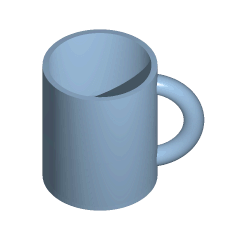“So, what kind of math do you study?”
Whenever someone finds out that I am a graduate student studying mathematics, that’s invariably one of the questions that they ask. (Other favorites include “What applications does it have to the Real World™?” and “Do you want to become a professor?” But that’s for another time.)
The type of math that I study (homotopy theory!) is a rather abstract and esoteric subfield of mathematics that is perhaps difficult to motivate or explain without a lot of prerequisite machinery and/or time.
So when trying to explain the math that I study to someone with little or no background in mathematics at all, I often find myself attempting to explain the broader subject area of topology, which encompasses what I do.
The classic explanation that I’ve heard many times is that topology is the study “rubber-sheet” geometry, in the sense that we can stretch and bend and deform the mathematical objects that we study, as this somehow does not affect the intrinsic properties that we consider. We must be careful, however, not to puncture and tear them, as these actions do change the intrinsic properties of our objects.
The quintessential example that goes along with this explanation is the mumbling that in this setting, coffee mugs are “the same” as donuts, and that both are “different” from spheres.
I hate it.
The first reason is that it’s both hard to explain and hard to understand. For a seasoned topologist, it’s easy to visualize the necessary contortions to transform a coffee mug to a donut. For someone who has never thought about it before, it usually doesn’t make much sense. And while there are some great GIFs on Wikipedia to help illustrate what’s going on, I’d rather not need to pull out my phone every time I need to explain what I do.

The more serious issue I have with this explanation, however, is that while it gives some insight into the way topologists think, it presents topology as an abstract novelty, and it isn’t clear at all why one would care about it. So instead let me present a different explanation of topology which has worked better for me.
—
One misconception that a lot of non-mathematicians have is that we already know everything to know in mathematics. They’re used to having equations and formulas that allow you to say “this quantity is that”. They’re used to dealing with numbers and concrete objects and data.
However, the truth is that we are not nearly so lucky. (If we did, then algebraic topology would not be so interesting!) It is often the case that we must deal with mysterious mathematical objects that are given to us by abstract definitions, existence theorems, universal properties, etc. Therefore, the questions we deal with tend to be of the form
“Are these two things ‘the same’?”
and/or
“How can we tell them apart?”
It is then our job to find ways to demystify and understand these objects, as we usually cannot access them directly – much like an archaeologist would like to study an ancient civilization, or a paleontologist a species of dinosaur, without being able to travel back in time to see them firsthand.
Nevertheless, both paleontologists and archaeologists have various tools that they can use to indirectly understand the objects of their study, such as fossils, fossil records, trace fossils, or radiocarbon dating. In other words, both paleontologists and archaeologists study the data that they can access, and can obtain from this data a picture of what is going on.
In the same way, topologists have analogous tools: we calculate what are called (homotopy) invariants such as Euler characteristic, co/homology groups, homotopy groups, etc. The best of these invariants are both computable (or at least tractable), as well as powerful, in the sense that we can recover much of the information about the object we wish to study just by understanding the invariant.
That, in my eyes, is at the heart of what topologists do. My particular branch of topology, algebraic topology, brings topological questions (when are two things “the same” or “different”?) into a realm (algebra!) where we can compute things and answer questions more easily. And the particular subfield of algebraic topology that I study, homotopy theory, determines what it means for two things to be “the same” or “different”. It turns out that this is both useful in the real world and interesting mathematically, and I hope to tell you about next time.
It’s been months. When is “next time” going to be?!
LikeLike
I liked this. It’s interesting to hear some insight into how you see math. I like that your discussion is well thought out too. The editing also seems very well done. Nice work.
LikeLike